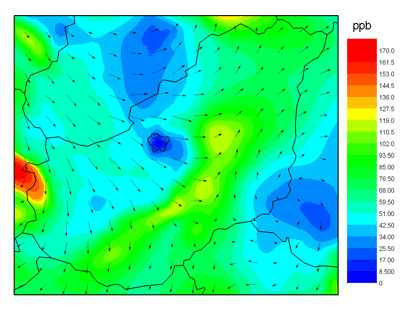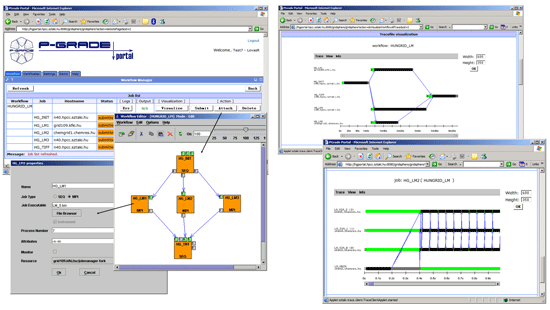
This issue in pdf Subscription Archive: Next issue: July 2005 |
|
|||||||
Chemistry GRID and its Applications for Air Pollution Forecastingby Róbert Lovas, István Lagzi, László Kullmann and Ákos Bencsura Computational Grid systems are becoming increasingly popular in the natural sciences. In such systems, a large number of heterogeneous computer resources are interconnected to solve complex problems. The main aim of the national research project funded by the Hungarian Ministry of Education, 'Chemistry Grid and its Applications for Air Pollution Forecasting', was to look at feasible applications of Grid technology in computational chemistry from a practical point of view; for example, prevention of the harmful effects of high-level ozone concentrations. In the project, the consortium (SZTAKI; Chemical Research Institute of the Hungarian Academy of Sciences; Department of Physical Chemistry, Eötvös University; Hungarian Meteorological Service) applied new Grid technologies to provide support for a specific research area. The developed infrastructure now provides chemists with access to both Hungarian computational Grid resources, called HUNGRID, and European-wide chemistry Grid infrastructures. The latter were established as the result of the EU-funded projects SIMBEX and EGEE. SZTAKI has elaborated a product line: a Grid-monitoring tool called Mercury, and two integrated application development environments, called P-GRADE parallel programming environment, and P-GRADE Grid portal (see Figure 2). These tools enable the efficient and transparent parallelization of sequential applications through their high-level graphical approach and special performance debugging and analyser tools. In the framework of the project, the P-GRADE portal was developed further to provide support for the efficient execution of complex programs in various Grids, eg in HUNGRID. It included the dynamic execution of applications across Grid resources according to the actual state and availability conditions provided by the new information system. Consequently, HUNGRID is not only a virtual organization within the EGEE: its new elements make it easier to use the infrastructure for solving complex problems, such as the modelling of air pollution.
The phytotoxic nature of ozone was recognized decades ago. Due to high emissions of ozone precursor substances, elevated ozone concentrations may cover large areas of Europe for shorter (episodic) or longer periods under certain meteorological conditions. These elevated concentrations can be potentially damaging to agricultural and natural vegetation. Occasional extreme concentrations may cause visible injury to vegetation, while long-term exposure, averaged over the growing season, can result in decreased productivity and crop yield. A coupled Eulerian photochemical reaction-transport model and a detailed ozone dry-deposition model were developed to investigate ozone fluxes over Hungary. The reaction-diffusion-advection equations relating to air pollution formation, transport and deposition are solved on an unstructured triangular grid. The model domain covers Central Europe including Hungary, which is located at the centre of the domain and is covered by a high-resolution nested grid. The sophisticated dry-deposition model estimates the dry-deposition velocity of ozone by calculating the aerodynamics, the quasi-laminar boundary layer and the canopy resistance. The meteorological data utilized in the model were generated by the ALADIN meso-scale limited-area numerical weather prediction model, which is used by the Hungarian Meteorological Service. The work demonstrates that the spatial distribution of ozone concentrations is a less accurate measure of the effective ozone load than the spatial distribution of ozone fluxes. The fluxes obtained show characteristic spatial patterns, which depend on soil moisture, meteorological conditions, ozone concentrations and the underlying land use (see Figure 1).
This project has demonstrated that the Grid is an efficient computer system for supporting complex collaborative work. Applications for air pollution forecasting (elaboration of smog alert response plans and a Gaussian plume simulation) have been developed and presented. The project partners have designed a collaborative application that runs on Grid to forecast air pollution in Hungary. The same application can be used to simulate earlier smog events and to analyse the efficiency of smog alert response plans and the long-term effects of various measures against air pollution Link: Please contact: |
|||||||



